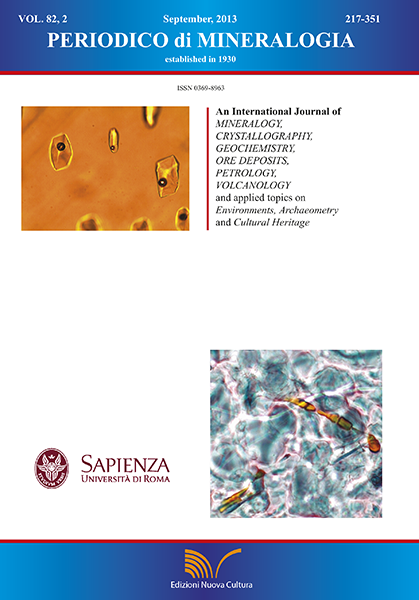Geology, Mineralogy and Fluid inclusions investigation of the Fluorite deposit at Jebel El Kohol, northeastern Tunisia
DOI:
https://doi.org/10.2451/2013PM0013Keywords:
Jurassic carbonates, Tunisia Jebel El Kohol, fluorite, fluid inclusions, Mississipi Valley-type depositAbstract
The Jebel El Kohol F-(Ba-Pb-Zn) deposit is located in northeastern Tunisia, 90 Km to the South of Tunis. The potential reserves are estimated in 0,4 Mt with 10% CaF2, 2% PbS, 1% ZnS and 2% BaSO4. The geology of the area is dominated by folded and thrusted structures of Cretaceous and Jurassic age which are organised in massive limestone units. Fluorite and sulphides mineralization are mainly associated with dolomitized and silicified Jurassic dolostone. The ore appear as carbonate replacement type and open space fillings type. Aqueous and aqueous with carbonic component (CO2) fluid inclusions from the El Kohol fluorite mineralized area were analysed. The vein-type fluid inclusions (type F1) show homogenization temperature between 105 °C and 137 °C with salinities between of 15 to 19 equiv wt% NaCl. Type F2 : Final ice-melting temperatures (Tm-ice) in the primary inclusions of the massive purple fluorite range from -16 °C to -12.5 °C corresponding to a salinity of 16 to 18.75 wt% NaCl. The homogenisation temperatures values range from 125 °C to 137 °C.
The fluid inclusions in massive white fluorite or type Karst have homogenization temperatures ranging from 115 °C to 140 °C (Type F3) and salinities ranging between 15 to 18 equiv. wt% NaCl.
The homogenization temperature and the salinity measured in fluid inclusions of white and purple fluorite in veins and massive types show close similarities. Microthermometric data indicates that the homogenization temperature and salinities of fluid inclusions in purple fluorite are generally higher than those of fluid inclusions in white fluorite. For the fluorite deposit in the Jebel El Kohol, two end member fluids can be defined: (A) a moderate-temperature (> 100 ºC), moderate salinity (< 20 equiv. wt% NaCl) brine for fluorite F1 and F2, and (B) a high salinity (> 20 equiv. wt% NaCl) fluid with a high temperature higher than 115 ºC for fluorite F3.
Raman microspectroscopy shows that aqueo-carbonic fluid inclusions contain CO2. The Pb-isotopic values from galena are close to upper Crust values. These data suggests that galena mineralization occurred from remobilization of lead from crustal rocks. The Jebel El Kohol fluorite deposit is characterized by simple mineralogy, epigenetic features. The present fluid inclusions study demonstrates the involvement of basinal brines to form the fluorite deposit of Jebel El Kohol. Combined field, mineralogical, isotopic and geochemical data allow to include the Jebel El Kohol ore deposit within the large class of Mississippi Valley-type F-(Pb) deposits.


